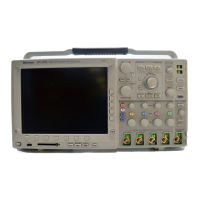Behavior. Use this trigger to analyze Serial Peripheral Interface Bus data.
You must supply the following inputs to analyze standard configuration SPI frames:
■
Slave Select (SS) Source control line
■
Serial Clock (SCLK) Source
■
Serial Data In (MISO) Source or Serial Data Out (MOSI) Source
The SS, SCLK, and Data Active controls allow compensation for inverted signals or synchronization on the falling edge of the
clock, if applicable.
NOTE. For low-speed serial triggering on data streams, the instrument implicitly pads the MSB side of the entered value, up to
the next byte, with "don't care" values (X). To trigger on a two-byte message, you must enter don't care values explicitly up to the
desired size.
For example, a binary entered value of 01 is equivalent to XXXX XX01, whereas a two-byte message would be entered as XXXX
XXXX XXXX XX01.
When you click on the trigger window controls, the trigger graphic shows the trigger sequence.
Trigger graphic
The trigger graphic displays a visual indicator of the trigger criteria. Depending on the trigger type, the instrument will update the
graphic as you define the trigger parameters.
Set up a logic state trigger
NOTE. The Logic State Trigger Control Window option is available only on MSO5000B and MSO70000C/DX Series instruments
and on DPO5000B Series instruments with option MSOE installed, and DPO70000DX instruments with option MSOU installed.
From the Trig menu, select Logic State Setup.
Overview. The trigger setup includes the D15-D0 digital channels on MSO instruments. DPO models show only Ch1 - Ch4
analog channels. Use the controls in this window to set up the Logic State trigger parameters.
Trigger setups
428 DPO70000SX, MSO/DPO70000DX, MSO/DPO70000C, DPO7000C, and MSO/DPO5000B Series

